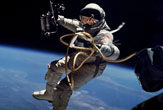
A new study investigated how astronauts' bones compare to those of Earthbound folks over time, and the results are not encouraging for space travelers.
Scientists have known for years that exposure to microgravity rapidly weakens bones, and the new research shows the effects can last for a year or more after astronauts return to Earth. The results stress the need to find ways to minimize the damage done during spaceflight, researchers said, because bone recovery on Earth may take a while.
"If we can intervene in space and have crewmembers not lose as much, that would be the best outcome for them," said study leader Shreyasee Amin, an associate professor at the Mayo Clinic in Minnesota.
Measuring bone density
Amin and her colleagues studied 28 American astronauts — 24 men and four women. Their preflight ages ranged from 36 to 53, and their missions in space lasted from 95 to 215 days.
The researchers measured the spaceflyers' bone mineral density — an estimator of bone strength — before launch, immediately after landing and again at various times between six and 18 months following their return to Earth.
For a control, the scientists took similar measurements from a sample of 699 people who had never been to space. By comparing the two datasets, the team was able to determine what the astronauts' bone density likely would have been, had they never flown in space.
Get the world’s most fascinating discoveries delivered straight to your inbox.
The team found that some bones remained weak even a year after the astronauts landed, despite intensive exercise and rehabilitation regimes. Hip bone mineral density in particular suffered, Amin said, while other areas, such as the wrist, bounced back faster.
Bones in the hips and legs need to be strong on Earth, because they lug so much weight around on a daily basis. But microgravity frees them of this burden and they seem to weaken as a result, researchers said.
"The hypothesis has always been that it's the lack of load-bearing activity in the lower extremities," Amin told SPACE.com. "And that seems to be panning out."
The team also found that women suffer less bone loss than men over the long haul. But since there were only four female astronauts in the sample, the team isn't sure what to make of this intriguing result yet; they're still looking at the data.
"There are a few things we need to dice out before we make any definitive decision that we should only send women to space," Amin said with a laugh.
Amin and her colleagues will present their results Tuesday, Nov. 9, at the American College of Rheumatology Annual Scientific Meeting in Atlanta.
Astronauts already training hard
Previous studies have shown that astronauts' bone mineral density drops by up to 1.8 percent every month they spend in space — a rate comparable or to exceeding the decline senior citizens experience during a full year on Earth.
The physical toll of space missions is no surprise to NASA. The space agency has long known about the problem, and astronauts routinely train hard to stave off the worst effects of bone loss and muscle-wasting in space.
During their six-month stints aboard the International Space Station, astronauts exercise about 2 1/2 hours per day, six days a week, officials have said. Spaceflyers ride a stationary bike, run on a treadmill and lift weights using a machine — installed on the station in November 2008 — that generates loads using vacuum cylinders. [Gallery: Inside the International Space Station.]
And after they return to Earth, NASA puts crewmembers through a customized exercise program that can last up to three months.
These exercise regimes may end up making a big difference, helping astronauts' bones stay strong in orbit. But Amin said her team would need more time to flesh out the effects.
"NASA's been really proactive in trying to find some interventions and improve their exercise capacity, not just for crewmembers' bones but also their muscles and well-being in general," she said. "That may be working. But we don't have sufficient data on this newer exercise equipment that has come up on the station."
Risk factors and recommendations
The bone-loss results are just the first stage of the researchers' study. They're continuing their work, looking at bone density two to four years after landing. And they're trying to identify risk factors that lead to bone loss and slow recovery, as well as ways that astronauts' health can be improved.
The team is integrating information about the astronauts' exercise regimes and biochemical markers that may influence bone loss and rates of recovery. They're also thinking about other factors that may contribute to bone weakening, such as vitamin D deficiency, Amin said.
The scientists hope that, over time, they can develop solid recommendations for how to help keep astronauts' bones healthy in space, and perhaps also how to help them recover once they return to Earth. The new study is a step along that path.
"It's an interesting first step," Amin said. "We're interested in working with NASA further to try to come up with some information that may help them and the astronauts long-term."
- Quiz: Reality of Life in Orbit
- Video: How Astronauts Work Out in Space
- Trip to Mars Would Turn Astronauts Into Weaklings
This article was provided by SPACE.com, a sister site of LiveScience.com.

 Live Science Plus
Live Science Plus





